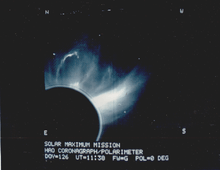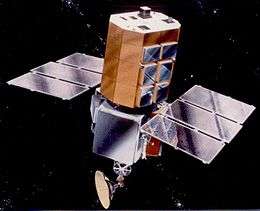Solar Maximum Mission
The Solar Maximum Mission satellite (or SolarMax) was designed to investigate Solar phenomena, particularly solar flares. It was launched on February 14, 1980. The SMM was the first satellite based on the Multimission Modular Spacecraft bus manufactured by Fairchild Industries, a platform which was later used for Landsats 4 and 5[1] as well as the Upper Atmosphere Research Satellite.
The Solar Maximum Mission ended on December 2, 1989, when the spacecraft re-entered the atmosphere and burned up.
Instruments
Experiments on board the Solar Maximum Mission
| Name | Target | Principal Investigator |
| Coronagraph/Polarimeter: 446.5-658.3 nm, 1.5- 6 sq.solar radii fov, 6.4 arcsec res. | Solar corona, prominences, and flares | MacQueen, Robert M., High Altitude Observatory |
| Ultraviolet Spectrometer and polarimeter 175.0-360.0 nm raster imager, 0.004 nm sp.res. | Solar UV, Earth's atmosphere | Tandberg-Hanssen, Einar A., NASA Marshall Space Flight Center |
| Soft X-ray Polychromator: raster imager, crystal spectrom. in parts of 0.14-2.25 nm | Solar flares, active solar regions | Acton, Loren W., Lockheed Palo Alto, Culhane, J University College, London, Leonard, Gabriel, Alan-Henri, Rutherford Appleton Laboratory |
| Hard X-ray Imaging Spectrometer: fov 6.4 arcmin, 8 or 32 arcsec res, 3.5-30 keV | Solar active regions and flares | de Jager, Cornelis, University of Utrecht |
| Hard X-ray Burst Spectrometer: CsI(Na), 15 energy channels covering 20-260 keV | Solar flares and active regions | Frost, Kenneth J., NASA Goddard Space Flight Center |
| Gamma-ray Spectrometer: NaI(T1),0.01-100 MeV in 476 channels, 16.4 s per spectrum | solar gamma-rays | Chupp, Edward L, University of New Hampshire |
| Active Cavity Radiometer Irradiance Monitor: 0.001-1000 micrometer solar flux | solar irradiance | Willson, Richard C, NASA Jet Propulsion Laboratory |
|
Failure and repair
In November 1980, the second of four fuses in SMM's attitude control system failed, causing it to rely on its magnetorquers in order to maintain attitude. In this mode, only three of the seven instruments onboard were usable, as the others required the satellite to be accurately pointed at the Sun. The use of the satellite's magnetorquers prevented the satellite from being used in a stable position and caused it to "wobble" around its nominally sun-pointed attitude.[2]
The first orbiting, unmanned satellite to be repaired in space, SMM was notable in that its useful life compared with similar spacecraft was significantly increased by the direct intervention of a manned space mission. During STS-41-C in 1984, the Space Shuttle Challenger rendezvoused with the SMM, astronauts James van Hoften and George Nelson attempted to use the Manned Maneuvering Unit to capture the satellite and to bring it into the orbiter's payload bay for repairs and servicing. The plan was to use an astronaut-piloted Maneuvering Unit to grapple the satellite with the Trunion Pin Attachment Device (TPAD) mounted between the hand controllers of the Maneuvering Unit, null its rotation rates, and allow the Shuttle to bring it into the Shuttle's payload bay for stowage. Three attempts to grapple the satellite using the TPAD failed. The TPAD jaws could not lock onto Solar Max because of an obstructing grommet on the satellite not included in the blueprints for the satellite. This led to an improvised plan which nearly ended the satellite's mission. The improvisation had the astronaut use his hands to grab hold of a solar array and null the rotation by a push from the Maneuvering Unit's thrusters. Instead, this attempt induced higher rates and in multiple axes; the satellite was tumbling out of control and quickly losing battery life. SMM Operations Control Center engineers shut down all non-essential satellite subsystems and with a bit of luck were able to recover the satellite minutes before total failure. The ground support engineers then stabilized the satellite and nulled its rotation rates for capture with the Shuttle's robotic arm. This proved to be a much better plan. The satellite had been fitted with one of the arm's "grapple fixtures" so that the robotic arm was able to capture and maneuver it into the shuttle's payload bay for repairs. During the mission, the SMM's entire attitude control system module and the electronics module for the coronagraph/polarimeter instrument were replaced, and a gas cover was installed over the X-ray polychromator.[3]Their successful work added five more years to the lifespan of the satellite. The mission was depicted in the 1985 IMAX movie The Dream Is Alive.
Findings

A coronal transient as seen by the SMM on May 5, 1980
Significantly, the SMM's ACRIM instrument package showed that contrary to expectations, the Sun is actually brighter during the sunspot cycle maximum (when the greatest number of dark 'sunspots' appear). This is because sunspots are surrounded by bright features called faculae, which more than cancel the darkening effect of the sunspot.
The major scientific findings from the SMM are presented in several review articles in a monograph.[4]
The SMM discovered ten sungrazing comets between 1987 and 1989.[5]
See also
References
- ↑ Suzuki, Masaharu (11 February 1999). "TOPEX/Poseidon - Description of Mission". University of Texas. Retrieved 9 July 2013.
The satellite bus was taken from the Multimission Modular Spacecraft (MMS), which has been proven on previous MMS-based missions: the Solar Maximum Mission and Landsat 4 and 5.
- ↑ "STS-41-C Press Kit" (PDF). NASA. Retrieved 9 July 2013.
All four of those instruments require pointing accuracy from the spacecraft and could not function effectively with the spacecraft spinning through space with its longitudinal axis pointed toward the sun, as it has since the attitude control system failure.
- ↑ "STS-41-C Press Kit" (PDF). NASA. Retrieved 9 July 2013.
Repairs to be made during the mission include replacing the attitude control system module, replacing the main electronics box on the Polarimeter/Polarimeter, and placing a cover over the gas vent of the X-Ray Polychrometer.
- ↑ Strong KT; Saba JLR; Haisch BM; Schmelz JT, eds. (1999). The many faces of the sun : a summary of the results from NASA's Solar Maximum Mission. New York: Springer. Bibcode:1999mfs..conf.....S.
- ↑ "JPL comet catalogue".
External links
|
|---|
| | Current | | |
|---|
| | Past | |
|---|
| | Planned | |
|---|
| | Cancelled | |
|---|
| | Sun-Earth | |
|---|
|
|
|---|
| | Main articles | |
|---|
| | Facilities | |
|---|
| Notable missions
and programs | |
|---|
| | People | Leadership |
- Christopher Scolese (Director)
- George Morrow (Deputy Director)
- Christyl Johnson (Deputy Director, Technology and Research Investments)
- Colleen Hartman (Deputy Director, Science, Operations and Performance)
|
|---|
| Notable scientists
and engineers | |
|---|
|
|---|
|
|
|---|
| Kosmos 1149 | Molniya 1-46 | OPS 6293 | Kosmos 1150 | Kosmos 1151 | Kosmos 1152 | Kosmos 1153 | Kosmos 1154 | Kosmos 1155 | OPS 2581 | OPS 5117 | Kosmos 1156 · Kosmos 1157 · Kosmos 1158 · Kosmos 1159 · Kosmos 1160 · Kosmos 1161 · Kosmos 1162 · Kosmos 1163 | Kosmos 1164 | SolarMax | Tansei-4 | Gran' No.16L | Kosmos 1165 | Ayame-2 | OPS 7245 (SSU-1 · SSU-2 · SSU-3) | Kosmos 1166 | Kosmos 1167 | Kosmos 1168 | Kosmos 1169 | Progress 8 | Kosmos 1170 | Kosmos 1171 | Soyuz 35 | Kosmos 1172 | Kosmos 1173 | Kosmos 1174 | Kosmos 1175 | OPS 5118 | Progress 9 | Kosmos 1176 | Kosmos 1177 | Kosmos 1178 | Kosmos 1179 | Kosmos 1180 | Kosmos 1181 | Kosmos 1182 | CAT-2 · Firewheel · FIRE B · FIRE C · FIRE D · FIRE E · Amsat-P3A | Soyuz 36 | Kosmos 1183 | NOAA-B | Kosmos 1184 | Soyuz T-2 | Kosmos 1185 | Kosmos 1186 | Kosmos 1187 | Gorizont No.15L | Kosmos 1188 | Meteor-Priroda No.3-1 | OPS 3123 | Molniya 1-47 | Kosmos 1189 | Progress 10 | Kosmos 1190 | Kosmos 1191 | Kosmos 1192 · Kosmos 1193 · Kosmos 1194 · Kosmos 1195 · Kosmos 1196 · Kosmos 1197 · Kosmos 1198 · Kosmos 1199 | Kosmos 1200 | Ekran No.19L | DMSP-5D1 F5 | Kosmos 1201 | Rohini RS-1B | Molniya 3-13 | Soyuz 37 | Kosmos 1202 | Kosmos 1203 | Kosmos 1204 | Kosmos 1205 | Kosmos 1206 | Kosmos 1207 | Kosmos 1208 | | Meteor 2-06 | GOES 4 | Soyuz 38 | Kosmos 1210 | Kosmos 1211 | Kosmos 1212 | Progress 11 | Kosmos 1213 | Gran' No.17L | Kosmos 1214 | Kosmos 1215 | Kosmos 1216 | Kosmos 1218 | Soyuz T-3 | Kosmos 1217 | OPS 6294 | Kosmos 1219 | Kosmos 1220 | Kosmos 1221 | SBS-1 | Molniya 1-48 | Kosmos 1222 | Kosmos 1224 | Kosmos 1225 | Intelsat V F-2 | OPS 3255 (SSU-1 · SSU-2 · SSU-3) · LIPS-1 | Kosmos 1226 | OPS 5805 | Kosmos 1227 | Kosmos 1228 · Kosmos 1229 · Kosmos 1230 · Kosmos 1231 · Kosmos 1232 · Kosmos 1233 · Kosmos 1234 · Kosmos 1235 | Prognoz 8 | Ekran No.20L | Kosmos 1236 | | Payloads are separated by bullets ( · ), launches by pipes ( | ). Manned flights are indicated in bold text. Uncatalogued launch failures are listed in italics. Payloads deployed from other spacecraft are denoted in (brackets). |
|




